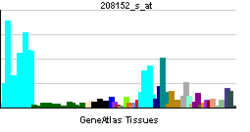- DDX21
-
DEAD (Asp-Glu-Ala-Asp) box polypeptide 21 Identifiers Symbols DDX21; DKFZp686F21172; GUA; GURDB; RH-II/GU; RH-II/GuA External IDs OMIM: 606357 MGI: 1860494 HomoloGene: 3473 GeneCards: DDX21 Gene EC number 3.6.4.13 Gene Ontology Molecular function • nucleotide binding
• RNA binding
• ATP-dependent RNA helicase activity
• helicase activity
• protein binding
• ATP binding
• hydrolase activityCellular component • nucleus
• nucleolusSources: Amigo / QuickGO RNA expression pattern 
More reference expression data Orthologs Species Human Mouse Entrez 9188 56200 Ensembl ENSG00000165732 ENSMUSG00000020075 UniProt Q9NR30 n/a RefSeq (mRNA) NM_004728 NM_019553.2 RefSeq (protein) NP_004719 NP_062426.2 Location (UCSC) Chr 10:
70.72 – 70.74 MbChr 10:
62.04 – 62.07 MbPubMed search [1] [2] Nucleolar RNA helicase 2 is an enzyme that in humans is encoded by the DDX21 gene.[1][2]
DEAD box proteins, characterized by the conserved motif Asp-Glu-Ala-Asp (DEAD), are putative RNA helicases. They are implicated in a number of cellular processes involving alteration of RNA secondary structure such as translation initiation, nuclear and mitochondrial splicing, and ribosome and spliceosome assembly. Based on their distribution patterns, some members of this family are believed to be involved in embryogenesis, spermatogenesis, and cellular growth and division. This gene encodes a DEAD box protein, which is an antigen recognized by autoimmune antibodies from a patient with watermelon stomach disease. This protein unwinds double-stranded RNA, folds single-stranded RNA, and may play important roles in ribosomal RNA biogenesis, RNA editing, RNA transport, and general transcription.[2]
Interactions
DDX21 has been shown to interact with C-jun.[3]
References
- ^ Valdez BC, Henning D, Busch RK, Woods K, Flores-Rozas H, Hurwitz J, Perlaky L, Busch H (Jun 1996). "A nucleolar RNA helicase recognized by autoimmune antibodies from a patient with watermelon stomach disease". Nucleic Acids Res 24 (7): 1220–4. doi:10.1093/nar/24.7.1220. PMC 145780. PMID 8614622. http://www.pubmedcentral.nih.gov/articlerender.fcgi?tool=pmcentrez&artid=145780.
- ^ a b "Entrez Gene: DDX21 DEAD (Asp-Glu-Ala-Asp) box polypeptide 21". http://www.ncbi.nlm.nih.gov/sites/entrez?Db=gene&Cmd=ShowDetailView&TermToSearch=9188.
- ^ Westermarck, Jukka; Weiss Carsten, Saffrich Rainer, Kast Jürgen, Musti Anna-Maria, Wessely Matthias, Ansorge Wilhelm, Séraphin Bertrand, Wilm Matthias, Valdez Benigno C, Bohmann Dirk (Feb. 2002). "The DEXD/H-box RNA helicase RHII/Gu is a co-factor for c-Jun-activated transcription". EMBO J. (England) 21 (3): 451–60. doi:10.1093/emboj/21.3.451. ISSN 0261-4189. PMC 125820. PMID 11823437. http://www.pubmedcentral.nih.gov/articlerender.fcgi?tool=pmcentrez&artid=125820.
Further reading
- Valdez BC, Henning D, Perlaky L, et al. (1997). "Cloning and characterization of Gu/RH-II binding protein.". Biochem. Biophys. Res. Commun. 234 (2): 335–40. doi:10.1006/bbrc.1997.6642. PMID 9177271.
- Valdez BC, Wang W (2000). "Mouse RNA helicase II/Gu: cDNA and genomic sequences, chromosomal localization, and regulation of expression.". Genomics 66 (2): 184–94. doi:10.1006/geno.2000.6209. PMID 10860663.
- Zhu K, Henning D, Valdez B, Busch H (2001). "Human RNA helicase II/Gu gene: genomic organization and promoter analysis.". Biochem. Biophys. Res. Commun. 281 (4): 1006–11. doi:10.1006/bbrc.2001.4446. PMID 11237763.
- Andersen JS, Lyon CE, Fox AH, et al. (2002). "Directed proteomic analysis of the human nucleolus.". Curr. Biol. 12 (1): 1–11. doi:10.1016/S0960-9822(01)00650-9. PMID 11790298.
- Westermarck J, Weiss C, Saffrich R, et al. (2002). "The DEXD/H-box RNA helicase RHII/Gu is a co-factor for c-Jun-activated transcription.". EMBO J. 21 (3): 451–60. doi:10.1093/emboj/21.3.451. PMC 125820. PMID 11823437. http://www.pubmedcentral.nih.gov/articlerender.fcgi?tool=pmcentrez&artid=125820.
- Valdez BC, Yang H, Hong E, Sequitin AM (2002). "Genomic structure of newly identified paralogue of RNA helicase II/Gu: detection of pseudogenes and multiple alternatively spliced mRNAs.". Gene 284 (1–2): 53–61. doi:10.1016/S0378-1119(01)00888-5. PMID 11891046.
- Strausberg RL, Feingold EA, Grouse LH, et al. (2003). "Generation and initial analysis of more than 15,000 full-length human and mouse cDNA sequences". Proc. Natl. Acad. Sci. U.S.A. 99 (26): 16899–903. doi:10.1073/pnas.242603899. PMC 139241. PMID 12477932. http://www.pubmedcentral.nih.gov/articlerender.fcgi?tool=pmcentrez&artid=139241.
- Henning D, So RB, Jin R, et al. (2004). "Silencing of RNA helicase II/Gualpha inhibits mammalian ribosomal RNA production". J. Biol. Chem. 278 (52): 52307–14. doi:10.1074/jbc.M310846200. PMID 14559904.
- Deloukas P, Earthrowl ME, Grafham DV, et al. (2004). "The DNA sequence and comparative analysis of human chromosome 10". Nature 429 (6990): 375–81. doi:10.1038/nature02462. PMID 15164054.
- Beausoleil SA, Jedrychowski M, Schwartz D, et al. (2004). "Large-scale characterization of HeLa cell nuclear phosphoproteins". Proc. Natl. Acad. Sci. U.S.A. 101 (33): 12130–5. doi:10.1073/pnas.0404720101. PMC 514446. PMID 15302935. http://www.pubmedcentral.nih.gov/articlerender.fcgi?tool=pmcentrez&artid=514446.
- Gerhard DS, Wagner L, Feingold EA, et al. (2004). "The status, quality, and expansion of the NIH full-length cDNA project: the Mammalian Gene Collection (MGC)". Genome Res. 14 (10B): 2121–7. doi:10.1101/gr.2596504. PMC 528928. PMID 15489334. http://www.pubmedcentral.nih.gov/articlerender.fcgi?tool=pmcentrez&artid=528928.
- Andersen JS, Lam YW, Leung AK, et al. (2005). "Nucleolar proteome dynamics". Nature 433 (7021): 77–83. doi:10.1038/nature03207. PMID 15635413.
- Yang H, Henning D, Valdez BC (2005). "Functional interaction between RNA helicase II/Gu(alpha) and ribosomal protein L4". FEBS J. 272 (15): 3788–802. doi:10.1111/j.1742-4658.2005.04811.x. PMID 16045751.
- Nousiainen M, Silljé HH, Sauer G, et al. (2006). "Phosphoproteome analysis of the human mitotic spindle". Proc. Natl. Acad. Sci. U.S.A. 103 (14): 5391–6. doi:10.1073/pnas.0507066103. PMC 1459365. PMID 16565220. http://www.pubmedcentral.nih.gov/articlerender.fcgi?tool=pmcentrez&artid=1459365.
- Olsen JV, Blagoev B, Gnad F, et al. (2006). "Global, in vivo, and site-specific phosphorylation dynamics in signaling networks". Cell 127 (3): 635–48. doi:10.1016/j.cell.2006.09.026. PMID 17081983.
- Ewing RM, Chu P, Elisma F, et al. (2007). "Large-scale mapping of human protein-protein interactions by mass spectrometry". Mol. Syst. Biol. 3 (1): 89. doi:10.1038/msb4100134. PMC 1847948. PMID 17353931. http://www.pubmedcentral.nih.gov/articlerender.fcgi?tool=pmcentrez&artid=1847948.
Categories:- Human proteins
- Chromosome 10 gene stubs
Wikimedia Foundation. 2010.
